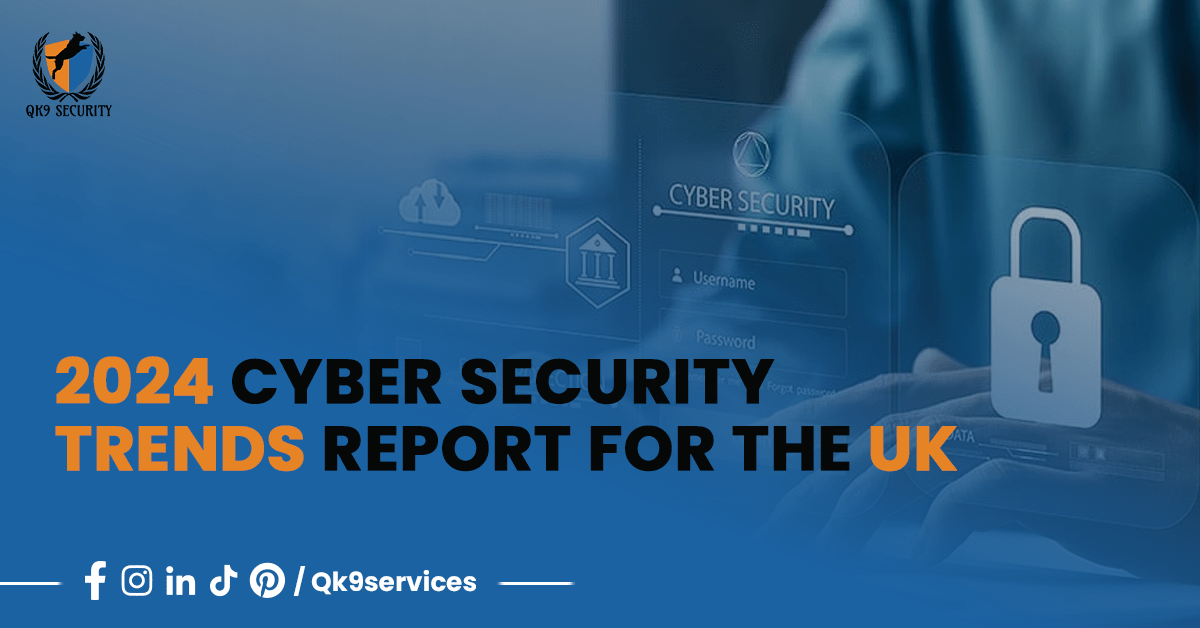2024 Cybersecurity Trends Report for the UK

Navigating the Evolving Cybersecurity Landscape in the UK:
Managing the UK’s Changing Cybersecurity Environment:
The UK’s cybersecurity environment is always changing in the ever changing digital ecosystem. Emerging technologies have the potential to revolutionize society, but they also introduce previously unheard-of attack surfaces and risk vectors that require careful mitigation. Understanding and adjusting to new trends is essential for successfully navigating this dynamic environment. This report looks at the major cybersecurity trends that will influence the UK’s digital environment in 2024, giving citizens and businesses the knowledge they need to strengthen their online security.
1. AI & ML Take Center Stage in Defense
Artificial intelligence (AI) and machine learning (ML) have transitioned from futuristic aspirations to pivotal tools in cybersecurity. AI and ML-powered solutions can analyze vast datasets in real-time, enabling the identification of anomalous behavior and the prediction of potential threats with unprecedented accuracy. One significant advancement in digital protection techniques is the shift toward anticipatory risk identification.
2. The Rise of Ransomware-as-a-Service (RaaS)

3. Social Engineering
The human element remains cybersecurity’s weakest link. While organizations invest heavily in technical defenses, social engineering attacks – particularly phishing and pretexting scams – continue to bypass sophisticated security measures by manipulating human psychology. These assaults often convince employees to voluntarily divulge login passwords or overcome protocols by appealing to natural instincts such as urgency and trust. In addition to awareness training, effective defense necessitates a cultural change that makes healthy skepticism and verification corporate reflexes, bolstered by layered security controls and transparent reporting protocols. As attack tactics grow more sophisticated with AI-generated content and deepfake technology, maintaining human vigilance is no longer optional – it’s the critical last line of defense in any comprehensive security strategy.
4. Cloud Security in Focus
The rapid migration to cloud environments demands a fundamental rethinking of traditional security approaches. As organizations embrace distributed architectures and shared responsibility models, conventional perimeter-based defenses prove increasingly inadequate. Because cloud systems are distributed, traditional perimeter-based security approaches find it difficult to provide sufficient security. Organizations must embrace cloud-native security solutions and establish a shared responsibility model with cloud providers to ensure comprehensive cloud security.
5. Supply Chain Attacks
The interconnected nature of modern supply chains creates a vast attack surface for cyber threats. Hackers exploit vulnerabilities in one vendor to gain access to other organizations further down the chain. To effectively combat supply chain vulnerabilities, organizations must embed security-by-design principles and cultivate verifiable trust across every tier of their supplier network.
6. The Expanding Attack Surface
The widespread adoption of Internet of Things (IoT) devices enhances the surface area vulnerable to cyberattacks. Many IoT devices have inherent security weaknesses, leaving them vulnerable to exploitation. To address this risk, businesses should adopt comprehensive device security protocols, including continuous vulnerability assessments and proactive threat mitigation strategies.
7. Geopolitical Landscape and Cyberwarfare
The landscape of cybersecurity is made more difficult by the emergence of cyberwarfare. With nation-states using cyberattacks to further their strategic political and economic goals, state-sponsored cyber operations have emerged as a preferred tool of geopolitical influence. Organizations must remain vigilant regarding evolving geopolitical threats and fortify their defenses accordingly.
8. Workforce Shortages and the Talent Gap
In order to combat growing cyberthreats, enterprises are critically understaffed due to a severe skills gap that still exists in the cybersecurity industry. To close this gap, efforts to draw and keep cybersecurity talent—such as expanded training programs and attractive remuneration packages—are essential.
The Importance of Cyber Resilience
Cybersecurity is a critical component of cyber resilience, encompassing various sub-components such as endpoint security, network security, and security awareness training. In an era of escalating cyber threats, pervasive digital connectivity, intricate market dynamics, and stringent compliance demands, cyber resilience has become a strategic imperative for business survival.
Regulatory Landscape and Compliance
The regulatory landscape surrounding cybersecurity is constantly evolving, with emerging regulations such as the NIS2 Directive in the EU. To avoid costly fines and safeguard their reputation, businesses must proactively monitor evolving regulations and embed compliance into their operational DNA.
Conclusion
The cybersecurity landscape in the UK is dynamic and continuously evolving. By understanding and adapting to the trends outlined in this report, organizations and individuals can navigate the evolving threat landscape and bolster their defenses against cyberattacks. To effectively combat evolving cyber threats, organizations must strategically integrate cutting-edge security solutions, comprehensive workforce training, and an enterprise-wide resilience mindset into their operational framework.
ALSO READ


2 thoughts on “2024 Cybersecurity Trends Report for the UK”
This post is so interesting. I can’t wait to read more from you.
Thank you for sharing this information! If you need some details about Airport Transfer than have a look here QH9